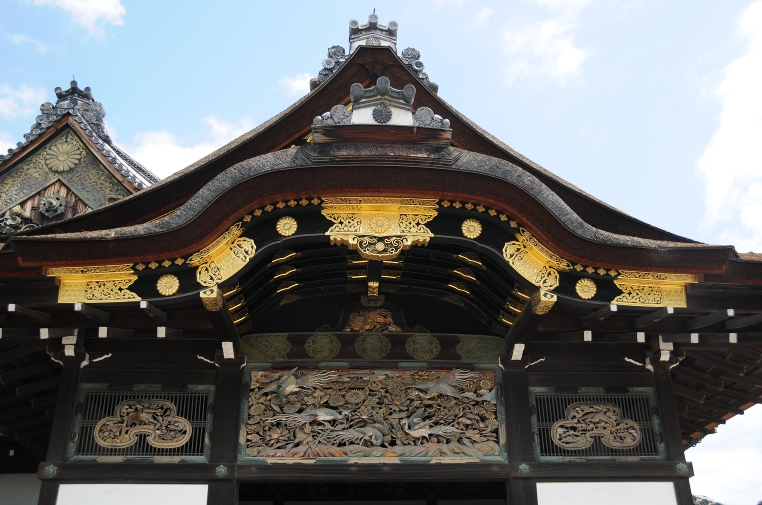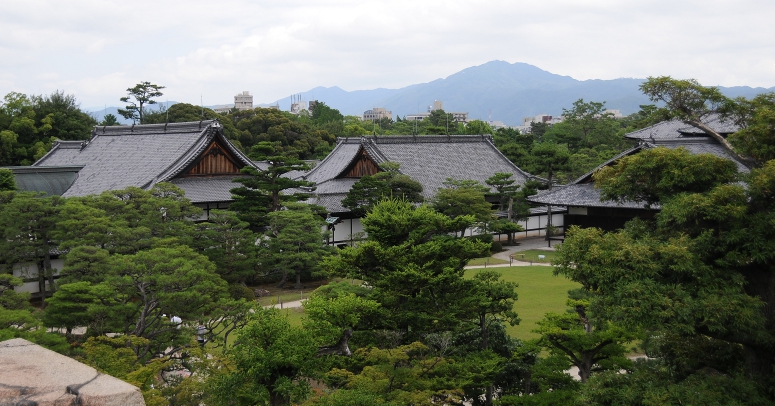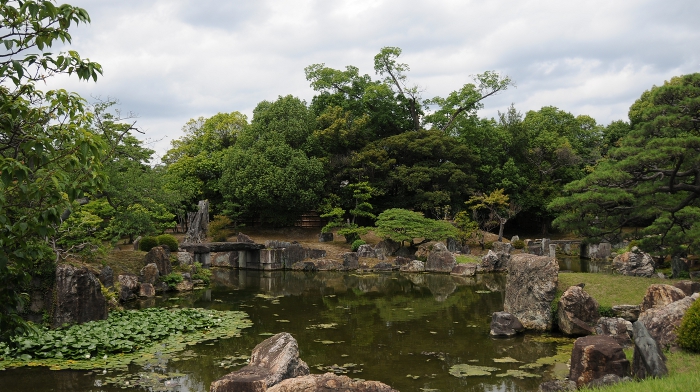One of my favourite places in Kyoto is Nijo-jo, the state residence of the Tokugawa shoguns of the Edo period. It is situated pretty much in the centre of Kyoto, southeast of the emperor’s palace, on Nijo-oji dori. It has been started on orders of the first shogun, Tokugawa Ieyasu, in 1601, but was completed only in 1626, under Ieyasu’s grandson, the third shogun.
The whole complex of Nijo-jo comprises 275.000 square metres inside a wide moat, but only 8000 square metres are built upon. There are actually two castles on the ground, the inner citadel called Honmaru is surrounded by a moat, and on the grounds outside of it, in the eastern gardens lies the actual residence of the shogun, Ninomaru, the second citadel. The Tokugawa shoguns actually resided in Edo, today’s Tokyo (hence the name Edo-period), but still they needed to show their wealth and influence in Kyoto where the emperor resided as well, lest the people would forget who’s actually ruling the country. All of Nijo castle is built from wood, and despite it having burnt down and been rebuilt just to be damaged by typhoons, it is still a highly impressive site.
 When the first moat is crossed, you enter Ninomaru palace through the Kara-mon gate. Ninomaru was designated as the residence of the shoguns (should they ever want to stay in Kyoto) and it is comprised of five buildings, all connected with corridors. As a visitor to the shogun, your entrance would be closely watched, and how far you would get inside the buildings would be determined by your rank – in Japan even then hierarchy was everything. You would start out by entering the retainer’s waiting rooms tozamurai-no-ma, go further to the formal reception room shikidai-no-ma and from there move on to the grand rooms ohiro-ma. Only very important people, for example messengers from the emperor would be allowed further into the inner audience chambers kuro-shoin.
When the first moat is crossed, you enter Ninomaru palace through the Kara-mon gate. Ninomaru was designated as the residence of the shoguns (should they ever want to stay in Kyoto) and it is comprised of five buildings, all connected with corridors. As a visitor to the shogun, your entrance would be closely watched, and how far you would get inside the buildings would be determined by your rank – in Japan even then hierarchy was everything. You would start out by entering the retainer’s waiting rooms tozamurai-no-ma, go further to the formal reception room shikidai-no-ma and from there move on to the grand rooms ohiro-ma. Only very important people, for example messengers from the emperor would be allowed further into the inner audience chambers kuro-shoin. The total floor space of Ninomaru palace measures 3300 square metres, divided into corridors and 33 rooms covered by more than 800 tatami mats. Each of the large rooms are divided into smaller rooms by sliding doors, and the rooms are named after the paintings on those doors. All of them are lavishly decorated with gold and exquisite paintings of plants, trees, or animals, and on top of the doors there are intricate wood carvings, often looking different depending from which side of the doors you look at them. At the end of all the long corridors there are the shogun’s living quarters, the shiro-shoin. They are relatively modest in size, compared to the rest of the palace, and only female servants were allowed to enter there, obviously for safety reasons.
The total floor space of Ninomaru palace measures 3300 square metres, divided into corridors and 33 rooms covered by more than 800 tatami mats. Each of the large rooms are divided into smaller rooms by sliding doors, and the rooms are named after the paintings on those doors. All of them are lavishly decorated with gold and exquisite paintings of plants, trees, or animals, and on top of the doors there are intricate wood carvings, often looking different depending from which side of the doors you look at them. At the end of all the long corridors there are the shogun’s living quarters, the shiro-shoin. They are relatively modest in size, compared to the rest of the palace, and only female servants were allowed to enter there, obviously for safety reasons.
Many more measures were taken to ensure the safety of Japan’s ruler. For example, in some of the rooms where the shogun would be present himself, there are doors behind which armed men would wait for the faintest sign of distress to enter and protect their master. Many castles have these, and the doors are usually well disguised. Not so in Ninomaru though – the shogun did obviously not buy into the idea of discreet hinting – here those doors are well visible, and even decorated with big red tassels. The most interesting protective features of Ninomaru palace however, are its corridors. They are made of plain wood, but the boards are placed on nails in a special way such that each person walking on them causes the construction to chirp like birds – hence the name uguisubari – nightingale floors. Walking on them is quite some fun, not only for school kids, and the idea was to prevent intruders from sneaking up the corridors and launching a surprise attack. Crossing the second moat leads you to Honmaru palace. This part of Nijo castle measures 16800 square metres, and it was once the home of a palace similar to Ninomaru and also sported a large five-story castle. However, both buildings were destroyed by fire in the 18th century already, and there has been no attempt to rebuild them. The present Honmaru building once stood on the grounds of the imperial gardens and was moved here at the end of the 19th century. It is not generally accessible, so I cannot say anything about its interior.
Crossing the second moat leads you to Honmaru palace. This part of Nijo castle measures 16800 square metres, and it was once the home of a palace similar to Ninomaru and also sported a large five-story castle. However, both buildings were destroyed by fire in the 18th century already, and there has been no attempt to rebuild them. The present Honmaru building once stood on the grounds of the imperial gardens and was moved here at the end of the 19th century. It is not generally accessible, so I cannot say anything about its interior.
The buildings are surrounded by beautiful Japanese gardens, three different ones stemming from three different periods: Ninomaru garden is the oldest, as it was constructed during the Edo period. Honmaru garden is the middle one, built in the Meiji period at the end of the 19th century, and the so called Seiryu-en garden is the youngest, having been constructed only in 1965.
 As I said, Nijo castle is beautiful, if you come to Kyoto, it is one of the places you must not miss! Nijo-jo is now a property of Kyoto city and has been open to the public since 1940; in 1994 it has been designated by the UNESCO as World Heritage Site. Unfortunately, because the paintings in Ninomaru are 400 years old, it is not allowed to take any pictures there. A few photos can be found on the official Kyoto city website for Nijo castle though.
As I said, Nijo castle is beautiful, if you come to Kyoto, it is one of the places you must not miss! Nijo-jo is now a property of Kyoto city and has been open to the public since 1940; in 1994 it has been designated by the UNESCO as World Heritage Site. Unfortunately, because the paintings in Ninomaru are 400 years old, it is not allowed to take any pictures there. A few photos can be found on the official Kyoto city website for Nijo castle though.
